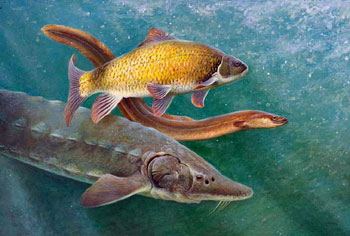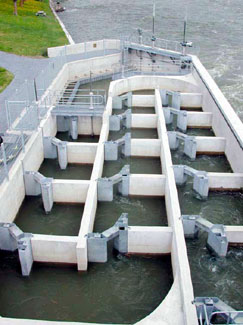page6
Saint-Ours Canal National Historic Site of Canada restores ecological connections
Ingenious passageway gives endangered fish access to Chambly spawning grounds and strengthens the Richelieu River's biodiversity
The Richelieu River, one of the largest tributaries of the St. Lawrence River, flows through the heart of Quebec's most populous area and is home to over 60 species of fish. The Saint-Ours dam, built in 1846, opened navigation on the Richelieu as far as New York City. The original dam added a fish ladder so that the impact on fish movement was minimal. However, when Transport Canada rebuilt the dam in 1969, the fishway was not replaced, with the result that by 1972, when Parks Canada acquired the site for the Saint-Ours Canal National Historic Site of Canada, the Saint-Ours dam had become a significant obstacle to fish.
Among those fish being blocked from swimming upstream to feed and spawn were four species at risk: Lake sturgeon, American shad, River redhorse and Copper redhorse. The only vertebrate species exclusive to Quebec, the Copper redhorse (Moxostoma hubbsi) has never been found anywhere else on earth. It inhabits a limited range that is increasingly threatened by agriculture, industrialization and urbanization. Today, the Richelieu River appears to be home to the only reproducing Copper redhorse population. The larger of two known spawning grounds is located in the Chambly Rapids, approximately 30 kilometres upstream from the Saint-Ours dam. The Copper redhorse was designated an endangered species by the Committee on the Status of Endangered Wildlife in Canada (COSEWIC) in 2004, as well as under Quebec's Loi sur les espèces menacées ou vulnérables in the spring of 1999.
 Painting of three fish © Parks Canada / G. Caron |
In 1996, Parks Canada and the Ministère de l'Environnement
et de la Faune met to plan a solution. Parks Canada formed a partnership with St. Lawrence Vision 2000–the multi-sector organization charged with protecting the St. Lawrence River–to begin addressing this problem. The design of the fish passage posed considerable technological challenges because the characteristics of the different fish had to be accommodated.
Specialists in hydraulic engineering, fish biology and fish ladder construction pooled their expertise and came up with plans for a multi-species fish ladder and a second fishway specifically designed for the American eel. Although fish ladders for salmon are commonly constructed, a multi-species fish ladder had never been built before. Designers had to consider factors such as the ability of various species to clear a vertical obstacle, the size of the pools required to hold the fish, water flow and different spawning run periods.
 Saint Ours fish ladder © Parks Canada / S. Paradis |
Parks Canada and its partners overcame these challenges and, in May 2001, the Vianney-Legendre Fish Ladder opened. Fish swarmed the ladder immediately. A year later, the first Copper redhorse was seen, swimming upstream to spawn.
Results
- The fish ladder was built to enable four vulnerable species of fish to again reach habitats located between the Chambly and Saint-Ours dams. In total, some 60 species of fish could benefit from the fishway.
- Over 32 species of fish have been observed in the fish ladder since it first opened in May 2001, including the Copper redhorse, the only vertebrate species exclusive to Quebec.
- The American eel, a much-valued commercial species that was once highly profitable in the St. Lawrence and Richelieu rivers, has regained access to Lake Champlain.
- Parks Canada and its partners overcame significant technical challenges to master the design and construction of a multi-species fish ladder. The fishway consists of single vertical slits for the redhorse, sturgeon and shad, as well as an eel ladder (an inclined surface next to the fish ladder), which was inspired by an experimental ladder used by Hydro Québec at the Chambly dam. European and American engineers have expressed interest in the innovative design.
- Date modified :